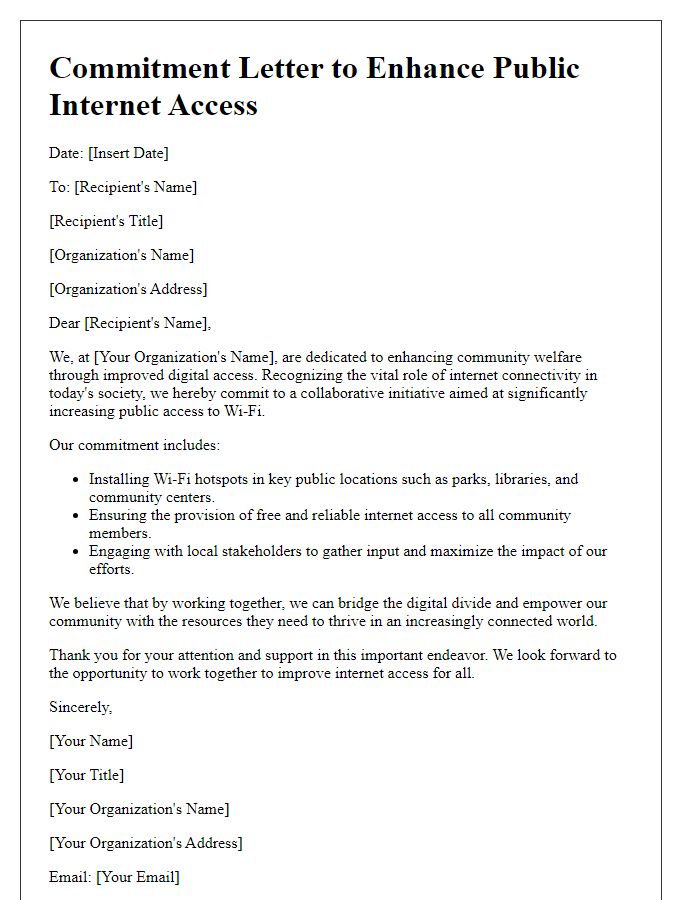Are you tired of searching for a reliable Wi-Fi connection in your community? Expanding public Wi-Fi access can transform our neighborhoods by connecting people to vital resources, jobs, and each other. Imagine a world where everyone, from students to seniors, can access the internet easily and affordably! Join us as we delve deeper into the benefits and implementation strategies for this important initiative.

Introduction and Objective Statement
Expanding public Wi-Fi access in urban areas, specifically in underprivileged neighborhoods, aims to bridge the digital divide and foster greater community engagement. Initiatives will target areas with limited internet connectivity, focusing on places like community centers and parks that offer residents essential resources. The current statistics indicate that nearly 30% of households in these neighborhoods lack reliable internet access, hindering opportunities for education and employment. By installing high-speed, secure Wi-Fi networks equipped with state-of-the-art technology, such as mesh networking systems, we aim to enhance digital literacy and improve quality of life. This proposal seeks partnership with local government and telecommunications companies to ensure sustainable implementation and maintenance. The ultimate objective is to empower residents with the tools needed to thrive in an increasingly digital world, thereby promoting inclusion and economic growth.
Benefits and Impact on Community
Expanded public Wi-Fi access can significantly enhance community connectivity and engagement, fostering a more inclusive digital environment. Increased internet access, particularly in underserved areas with limited broadband availability, allows residents to engage in remote learning, facilitating educational opportunities for students and adults beyond traditional settings. Economic growth in cities, like San Francisco, where community members leverage free Wi-Fi to support local businesses and entrepreneurship, demonstrates the power of connectivity. Public parks and community centers can serve as hotspots, encouraging social interaction while reducing the digital divide that affects marginalized populations. Enhancing digital literacy through workshops in these Wi-Fi zones can empower individuals with essential skills needed for today's job market, creating a more informed and capable workforce. Strategic planning for expanded Wi-Fi infrastructure can result in a healthier, more economically vibrant, and well-connected community.
Technical and Security Considerations
Expanded public Wi-Fi access can significantly enhance community connectivity, especially in urban areas with high foot traffic, such as Times Square in New York City. Implementing robust technical infrastructures, including fiber-optic cables and dual-band routers, enables high-speed internet access for thousands of users simultaneously. Ensuring user security necessitates protocols like WPA3 encryption to protect personal data and mitigate unauthorized access. Incorporating a captive portal for user authentication can enhance network integrity, while regular software updates safeguard against emerging cyber threats, such as malware and phishing attacks. Additionally, deploying firewalls and intrusion detection systems allows for proactive monitoring of network traffic, essential in maintaining a secure public Wi-Fi environment.
Budget and Funding Sources
Expanding public Wi-Fi access in urban areas can improve digital equity and inclusivity. The proposal outlines a budget of $500,000 for infrastructure development, including high-speed internet connections and installation of access points across 50 public locations, such as parks, libraries, and community centers. Funding sources can include federal grants (e.g., the Rural Digital Opportunity Fund), state allocations (such as the California Public Utilities Commission programs), and local government budgets. Partnerships with private telecom companies (like Verizon and AT&T) can also provide financial support and technological expertise, enhancing the project's sustainability and outreach. Monitoring and maintenance costs are estimated at $50,000 annually to ensure reliable service and user satisfaction. This initiative aims to bridge the digital divide, providing access to over 100,000 residents lacking reliable internet service.
Timeline and Implementation Plan
An expanded public Wi-Fi access initiative aims to provide free, high-speed internet connectivity in urban areas, enhancing digital inclusion for residents. The proposed timeline spans 12 months, beginning with a comprehensive needs assessment in January 2024, targeting 20 high-traffic locations across the city, such as parks, community centers, and public transportation hubs. By March 2024, infrastructure upgrades will commence, including the installation of fiber optic cables to support robust connectivity. In June 2024, deployment of wireless access points (APs) will start, ensuring coverage in all designated areas. A public awareness campaign will launch in July 2024, informing residents about availability and access protocols. By October 2024, a pilot testing phase will evaluate connectivity speeds and user experience, addressing any technical issues identified. Full-scale implementation and monitoring will commence in December 2024, aiming to achieve a stable and reliable Wi-Fi service by January 2025. Final evaluations and user feedback collection will occur in February 2025 to shape future expansions and improvements.
Letter Template For Expanded Public Wi-Fi Access Proposal Samples
Letter template of initiative to broaden public internet access through Wi-Fi.

Letter template of request for increased public Wi-Fi hotspots in community areas.

Letter template of appeal for support in expanding community Wi-Fi services.

Letter template of project outline for improved public Wi-Fi availability.

Letter template of commitment to elevate public internet access via Wi-Fi.

Letter template of plan to extend Wi-Fi coverage in urban neighborhoods.








Comments